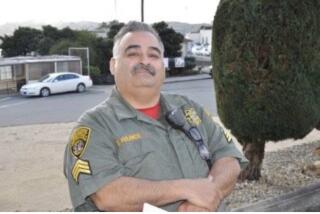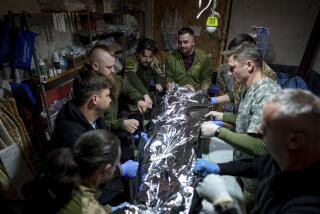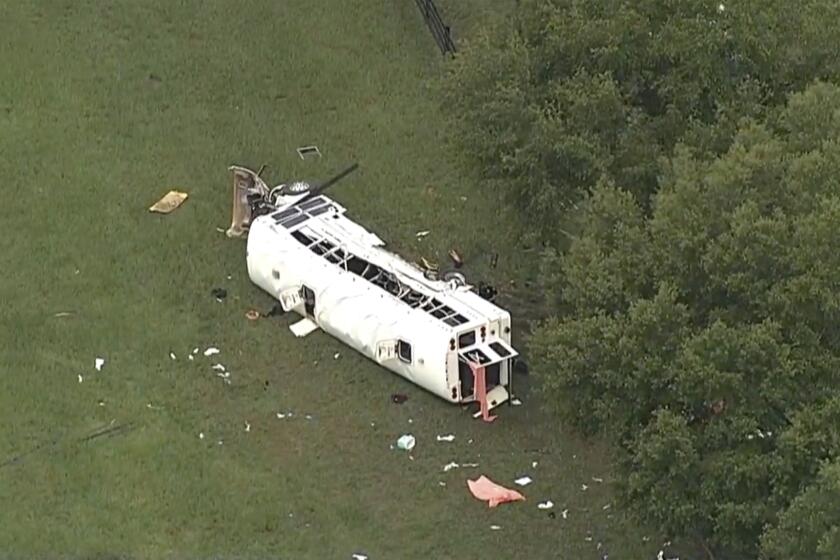Standoff Poses First Challenge to New Deadly Force Rules
Under pressure to resolve the “freemen” standoff in Montana before it reaches crisis proportions, federal law enforcement officials are determined to prevent the bloodshed that marked the Ruby Ridge, Idaho, shootout in August 1992 and the assault on the Branch Davidian compound near Waco, Texas, the next year.
A peaceful resolution to the current confrontation with armed tax protesters on a ranch near Jordan, Mont., could pose the first major challenge to new rules governing the use of deadly force that were adopted last fall for all agencies of the Justice Department and the Treasury Department, officials said.
A dozen armed freemen, as they call themselves, have holed up on the ranch and are resisting arrest on charges of financial crimes and fraud. Although two were lured out on Monday, authorities believe that at least 10 more fugitives are inside a large building on the ranch.
“In the past, not a lot of thought has been given to extraordinary situations in extraordinary times,” one official complained. “Hopefully, this time we’re more ready to handle the situation.”
The official, who spoke on condition of anonymity, acknowledged that federal law enforcement agencies are under pressure from Congress as well as other critics who believe that federal officers are prone to the quick use of excessive force.
The most recent sign of that concern was an anti-crime bill approved by House members earlier this month. The House removed from the bill expanded powers that U.S. lawmen said they needed to combat domestic terrorism. Many conservative House members, as well as some liberals, have said that law enforcement officers have overstepped their authority too readily in the past.
It is a theme that the right-wing militia movement has been stressing for a long time.
Last October, after Senate hearings into the Ruby Ridge tragedy, Justice Department officials unveiled new rules on deadly force. Although some said that the rules had been months in the making, their disclosure came as Congress began focusing on the deadly shootout, in which the wife and 14-year-old son of anti-government fugitive Randy Weaver and a federal marshal were killed.
Deputy Atty. Gen. Jamie S. Gorelick told the Senate Judiciary subcommittee on terrorism that a uniform, written policy had been adopted in an effort to avoid similar tragedies in the future. The policy would apply to all law enforcement units of both Justice and Treasury, including the FBI, the Drug Enforcement Administration, the Secret Service and the Bureau of Alcohol, Tobacco and Firearms.
The policy provides that lawmen “may use deadly force only when the officer has a reasonable belief that the subject of such force poses an imminent danger of death or serious physical injury to the officer or to another person.”
It adds this provision: “Deadly force may not be used if an alternative reasonably appears to be sufficient to accomplish the law enforcement purpose.”
Subcommittee Chairman Arlen Specter (R-Pa.), who is planning additional hearings soon, said in an interview that “the lesson of Ruby Ridge is patience.”
Under hastily drafted “shoot-on-sight” rules that governed FBI snipers in the Ruby Ridge siege, Weaver’s son was shot as he ran up a path toward the cabin and Weaver’s wife, Vicki, was killed as she stood behind a half-opened door.
“I’m not on the scene,” Specter said in reference to the current Montana standoff. “So I don’t know details on the FBI’s ability to starve them out or wait them out.” But he added that, “if you have a group that’s isolated, as the freemen seem to be, you should starve them out if at all possible.”
As to the revised rules, Specter objected that they permit deadly force in the face of “imminent” danger, which he said the FBI is interpreting to be a lower standard to meet than “immediate” danger as enunciated in a Supreme Court decision. But he said that he is gratified that FBI Director Louis J. Freeh generally has ruled out exclusive use of the FBI’s hostage-rescue team--the marksmen who were present at Ruby Ridge--in situations where no hostages are being held.
Ruby Ridge did not involve a hostage situation; neither does the Montana siege. Officials said that as a result, the FBI has sent a variety of agents to the ranch, including behavioral specialists and negotiators as well as regional SWAT teams.
Critics have cautioned that moves against cults or anti-government protesters must be carefully thought out--not motivated by frustration or anger.
“You have to be very careful you don’t use force by way of retaliation,” Specter said.
Cult leader David Koresh and more than 80 of his followers died in the April 19, 1993, conflagration in Waco although federal investigators said that many appeared to have been shot by cult leaders.
Justice Department officials have said that an additional problem at Ruby Ridge was confusion among the FBI snipers over what circumstances would trigger a decision to fire their high-powered rifles.
Eugene Glenn, the FBI’s on-site commander, said that now-suspended FBI official Larry Potts approved rules that said snipers “should” fire on armed adults. Potts said the rules were not that firm and were open to an individual’s interpretation of a threat.
New rules now require that “senior leadership” of both the FBI and the Justice Department must take part in managing crises like the one unfolding in Montana.
Meanwhile, in Billings, Mont., two anti-government extremists were arraigned on federal charges Thursday at a hearing in which they tried to shout down the judge.
U.S. Magistrate Richard Anderson entered pleas of not guilty for LeRoy Schweitzer, 57, and Daniel Petersen Jr., 53, after the two started shouting at the hearing and refused to enter pleas on their own behalf.
They were arrested Monday on charges of developing a scheme to defraud financial institutions, public agencies and businesses and with threatening the life of a federal judge in Montana.
More to Read
Start your day right
Sign up for Essential California for news, features and recommendations from the L.A. Times and beyond in your inbox six days a week.
You may occasionally receive promotional content from the Los Angeles Times.





